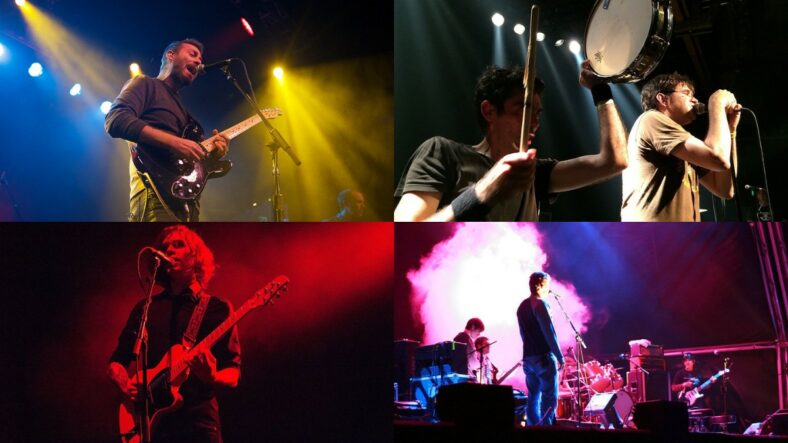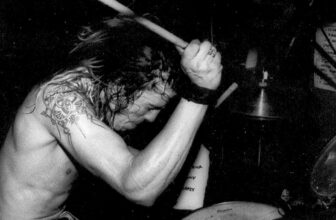What is Math Rock?

math rock is an innovative genre of rock music known for complex guitar riffs, unusual harmonies, abrupt changes in style and tempo, and odd time signatures. This style blends elements of jazz, progressive rock, and classical music with an indie-rock sensibility.
In understanding math rock, it’s essential to note that it demarcates itself from conventional rock due to its focus on complex, atypical rhythms. The genre gained prominence in the late 80s and has gradually evolved, with bands now often integrating electronic effects and extended techniques. The elements of math rock encompass intricate guitar riffs, asymmetrical time signatures, and non-standard drumming patterns that require highly developed skills.
Notable bands like Don Caballero, Shellac, Battles, and Tera Melos have significantly driven this genre through their mastery of pioneering techniques. The uniqueness of math rock lies not just in the unusual time signatures but the distinct use of instruments such as the fretless bass. Finally, decoding math rock necessitates an openness to melodious complexity, as the genre often avoids traditional harmonies and song structures.
Contents
Math Rock At A Glance
- Math rock is a complex genre of rock music distinguished by its complex rhythms, intricate melodies, and atypical time signatures.
- Key elements of math rock include intricate guitar riffs, asymmetrical time signatures, counterpoint melodies, and extended chords.
- Math rock traces its roots back to the late 1980s, with bands including King Crimson, American Football, CHON, Toe, and Tool pioneering this genre.
- Elements like fretless bass and synthesizers are often incorporated, offering a sonic experience that transcends traditional rock music.
- Decrypting math rock requires knowledge of its history, technical proficiency, and an understanding of its relationship with other genres.
1. Understanding Math Rock
Math Rock is a distinctive genre characterized by its intricate, complex rhythms and non-standard time signatures. It is often associated with indie and alternative genres, as it borrows elements from them to create unique sonic textures that conveniently avoid mainstream musical troupes like pop. This genre intersects rock with a more intellectual or experimental structure – think of it as the epitome of unconventional intricacy within rock music.
The concept of math rock traces its roots back to bands like King Crimson and Rush. These bands pioneered a genre of music that pushed the boundaries of traditional rock, combining elements of jazz, classical, and progressive music. Their affinity for the unorthodox, in both rhythm and melodic structure, paved the way for a sub-genre where mathematical precision meets musical spontaneity. Understanding math rock, therefore, is about appreciating this integration of intricate musical elements within the umbrella of rock.
2. Elements of Math Rock
The elements that makeup math rock are a major part of what makes it so distinctive. This genre is ultimately defined by its complexity, with musicians often incorporating unusual, sophisticated, and imaginative components to make their sound stand out.
One of the key features is the use of complex, atypical rhythmic structures. Math rock music is rhythmically adventurous and frequently challenges the listener’s perception of time, establishing a fluctuating, undeniably intriguing soundscape.
Another defining aspect is the use of counterpoint, a technique where multiple melodies are played simultaneously, each retaining its individuality while complementing the others. This creates an immersive listening experience that is rich in texture and melodic diversity.
Moreover, math rock includes elements such as odd time meters. These deviate from the common 4/4 rhythm seen in many forms of music, adding a level of unpredictability that enhances the listening experience.
The main instruments are drums, guitar, and bass, while some math rock bands also take advantage of synthesizers. Some math rock tracks also have vocals, but the genre is more instrumental-based and features long instrumental and sophisticated passages.
Lastly, math rock songs often use extended chords. This means that they build on traditional chords with additional notes, giving the music an added depth and complexity. These various elements converge to form the unique, intricate tapestry that is math rock.
3. Evolution of Math Rock: A Brief History
As we delve into the history of math rock, it’s remarkable to see the evolution of a genre so distinct. The early origins of math rock can be traced back to the late 80s and early 90s, with bands like King Crimson causing ripples in the already deep pool of rock music.
A significant period in math rock history is associated with the midwestern region of the United States, particularly Chicago, and Louisville. This period saw the rise of a new wave of bands that put their own spin on the math rock genre, building off those unconventional rhythmic structures and odd time signatures.
One game-changing figure in this genre is Steve Albini, a musician and record producer who is often credited as an inspiration to many math rock musicians. Owner of the Electrical Audio recording studio in Chicago, Albini had a lasting influence on the sound and development of math rock. His intense, raw production style helped set the tone for much of what was to come in the genre.
This historical view underscores the gradual evolution of math rock from its roots in prog rock to the diverse, multifaceted genre it has become today. It’s a reminder of how math rock has continually stretched the boundaries of traditional rock music conventions, offering listeners a refreshing alternative with its complex, intricate style.
4. Notable Math Rock Bands
Math rock has produced several noteworthy bands that demonstrate the genre’s innovative complexity, and some have cemented their influence in its history. These bands have furthered the genre’s reputation as a dynamic blend of intricate melodies, complex rhythms, and unique time signatures.
- American Football, for example, played a key role in defining the genre. Their eponymous debut album is often cited as a math rock masterpiece due to its intricate song structures and introspective lyrics.
- Shellac is another highly popular math rock band led by the skilled guitarist Steve Albini. The band from Chicago is one of the pioneers of the genre and helped shape the math rock sound with their debut album, “At Action Park,” in 1994.
- CHON, a band from California, is known for its lightning-fast guitar riffs and complex rhythms. Their unique blend of progressive rock, jazz, and fusion has made them a central figure in the modern math rock scene.
- Slint is considered one of the best math rock bands of the ’90s and one of the pioneers of the genre, as they released their masterpiece album “Spiderland” back in 1991. They have used a post-rock sound inspired by other notable math rock bands like Shellac.
- Toe, a band from Japan, has made quite an impression. Their use of unconventional song structures, soft-vocal melodies, and unconventional instrumental arrangements has given them a unique place in the math rock world.
- TTNG or This Town Needs Guns, is another great math rock band that sits in the sweet spot between emo and math rock music. As the most beloved math rock band from the U.K., TTNG was formed in 2004 and is still active today.
- In the 20th century, one of the most notable math rock bands was Don Caballero, who was also one of the pioneers of the genre. The characteristic riffs of the guitarist Ian Williams glue the happy indie rock guitar riffs of the 80s and math rock together. He is also the founder of another great math rock band from New York, Battles.
These bands are just a taste of the wealth of talent found within the math-rock genre, each contributing their individuality and creativity to the continuously growing math-rock landscape.
5. Uniqueness of Math Rock: Instruments and Techniques
The uniqueness of math rock, beyond its complex rhythmic structures and odd time signatures, extends to its choice of instruments and playing techniques. The genre often showcases a significant intersection of traditional rock instrumentation with a twist of innovation and creativity.
- Guitars, both electric and acoustic, are central in math rock. Their usage isn’t merely confined to conventional techniques. Musicians often employ fingerstyle or sweep picking for intricacy, as well as using non-standard tunings.
- Drums serve as the backbone of math rock, providing the complex rhythms that define the genre. From irregular beats to unpredictable time signatures, drummers in math rock push the limits.
- Bass guitars, often fretless, contribute to the genre’s distinct sound. An array of techniques, from slapping to finger-picking, add a layer of melodic richness and rhythmical complexity.
- Synthesizers and effects pedals are increasingly becoming a part of math rock. They allow artists to experiment and develop a unique soundscape offering an immersive listening experience.
- The minimalist production is another key feature of the genre, as math rock tracks do not have large orchestration or overdubs. Most math rock songs are based on the guitar-bass-drum combination with a lead instrument or vocal. The effects used are fundamental, like reverb and compression.
- The key element or technique in math rock songs is ambitious songwriting, which features long instrumental passages.
The integration of these instruments and techniques propels the genre beyond traditional rock norms, reinforcing the distinctive character of math rock with its technical proficiency and innovative soundscapes.
6. Decoding Math Rock: FAQs
Understanding the complexities of math rock often triggers a series of frequently asked questions. Decoding it further, let’s demystify some of the common queries related to this genre:
Is there a connection between math rock and Midwest emo?
Indeed, some math rock bands, such as American Football, have significant influences from the Midwest emo scene. Both genres prefer complex, atypical song structures and intricate guitar work. The lines often blur between these genres, and many bands straddle the two in their music.
Is American Football considered math rock?
Yes, American Football has been a key player in the evolution of math rock. Their debut album, with its complex rhythmic structures and unconventional guitar techniques, is often cited as a seminal work in the genre.
Can Tool be classified as a math rock band?
While Tool is primarily known as a progressive metal band, they have certainly incorporated elements of math rock in their music. With their complex song arrangements, odd time signatures, and polyrhythms, Tool reflects the cross-pollination of rock subgenres.
Conclusion
In essence, math rock is a genre of music noted for its complex rhythms, intricate melodies, and unconventional approach, making it a fascinating exploration of musical craftsmanship. This genre, which has its roots in pioneering bands like King Crimson and Rush, integrates elements of rock, jazz, and alternative music in refreshing ways. Key figures like Steve Albini and bands, including American Football, CHON, and Toe, have shaped math rock, contributing to its distinct and evolving soundscapes.
What makes math rock unique extends beyond its rhythms and time signatures to its innovative use of guitars, drums, and bass. The genre continually challenges traditional rock norms and provides a platform for musicians to experiment and push the limits of their creativity.
To truly appreciate math rock, one must embrace the complex beauty it weaves in each song – a testament to the genre’s richness and musical prowess. As we continue exploring its depths, math rock endures as a testament to the wonders that can be achieved when musicians refuse to be tied down by the usual conventions, choosing instead to carve their own path in the wide world of rock music.
American Football Featured Image (Top-Left) by: Andy Witchger, CC BY 2.0, via Wikimedia Commons
Shellac Featured Image (Top-Right) by: Party diktator, CC0, via Wikimedia Commons
Chon Featured Image (Bottom-Left) by: BieberMcNasty, CC BY-SA 4.0, via Wikimedia Commons
Slint Featured Image (Bottom-Right) by: michael morel, CC BY 2.0, via Wikimedia Commons





